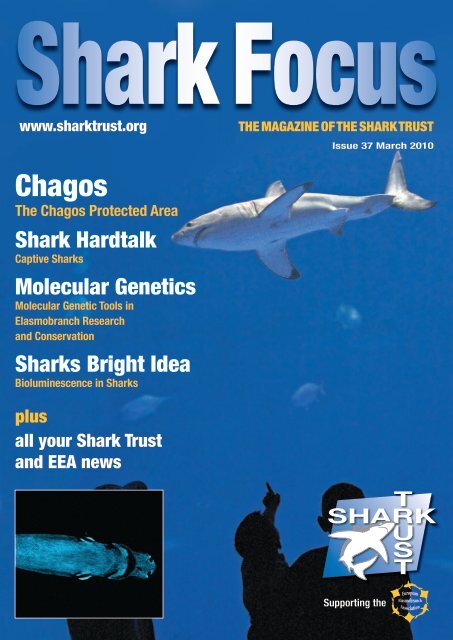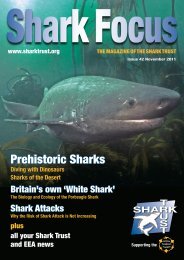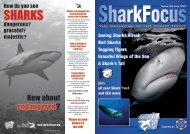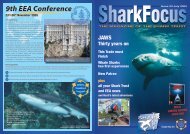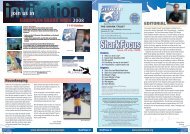Shark Focus
chagos - The Shark Trust
chagos - The Shark Trust
Create successful ePaper yourself
Turn your PDF publications into a flip-book with our unique Google optimized e-Paper software.
<strong>Shark</strong> <strong>Focus</strong>www.sharktrust.orgTHE MAGAZINE OF THE SHARK TRUSTIssue 37 March 2010ChagosThe Chagos Protected Area<strong>Shark</strong> HardtalkCaptive <strong>Shark</strong>sMolecular GeneticsMolecular Genetic Tools inElasmobranch Researchand Conservation<strong>Shark</strong>s Bright IdeaBioluminescence in <strong>Shark</strong>splusall your <strong>Shark</strong> Trustand EEA newsSupporting the
MEMBER’S pagesSCS Adriatic Blue <strong>Shark</strong> ExpeditionIn October last year I was a volunteer on the third<strong>Shark</strong> Conservation Society (SCS) Adriatic <strong>Shark</strong>research expedition. The main aim of this expeditionwas to investigate a suspected Blue <strong>Shark</strong> pupping/nursery area in the central Adriatic Sea.The Adriatic was once considered a hot spotfor sharks. Alen Soldo, a marine scientist from theUniversity of Split, Croatia, lists 28 shark speciespresent in the Adriatic (source: Alen Soldo, <strong>Shark</strong>s ofthe Adriatic Sea). Alen is the SCS Scientific Advisorfor the Mediterranean Sea.Despite the area having a wide diversity of marinefauna, very little of it occurs in any abundance. Mostspecies are severely depleted due to over fishing, lossof food source and pollution.Of the larger sharks, the Blue <strong>Shark</strong> is stillencountered frequently by sports fishermen, whileMako <strong>Shark</strong>, Porbeagle <strong>Shark</strong> and Thresher <strong>Shark</strong>catches are much rarer.The female Blue <strong>Shark</strong> gives birth in a pupping/nursery area after a gestation period of 9 – 12months. Birth usually occurs in spring or summer andthe number of pups ranges from 4 – 135. The averagelength of the pups at birth is 35 – 44cm. These pupsstay in the pupping area until they are about 130cmlong, after which they leave, and probably formaggregations according to sex (Collins Field Guide -<strong>Shark</strong>s of the World).Richard Peirce of the <strong>Shark</strong> Conservation Societyhad planned our expedition to the Kornati area ofCroatia, with the objective of gathering solid evidenceof a nursery which could be used as a scientificbasis to achieve protection for the area. We neededto encounter sharks with a length less than 130cm,together with a conspicuous lack of mature adults.Alen Soldo had long suspected that this was anursery area, his suspicions being based on theanecdotal evidence of numerous juvenile Blue <strong>Shark</strong>sEudi the charter vessel. © Andrew Sweeney.being caught locally by sports fishermen. A previous SCSexpedition in 2005 had caught, tagged, and released apup in this area, which supported Alen’s theory.Jezera, on Murter Island, was to be our land baseand the plan was to spend four days and nightsinvestigating the target area. Our chartered vessel“Eudi” was skippered by a local Croatian called Vlado,who has been on two previous SCS expeditions. TheKornati Islands are about 11 miles due west of Jezeraand the journey takes about 3 hours. We used datasheets to record date and time of arrival, latitudeand longitude, water depth, water visibility, watertemperature, wind conditions and sea state, and torecord the species we encountered and identified.We used sardines as chum and once in the water,the chum bags released a slick of fish oil which wascarried away from the boat by the current. This slick<strong>Shark</strong>s in <strong>Focus</strong> Competition Winner“It was such a pleasant shock to find out thatI had won this competition, and I feel reallyhonoured. As well as the bonus of havingthis great kit and vouchers, I think I get mostsatisfaction, as a supporter of the <strong>Shark</strong> Trust,in knowing that this image will not only helpraise awareness of how special sharks are,but also assist with the conservation of thesewonderful but threatened creatures.”Andrew Sweeneywas reinforced by a trail of minute fish fragments thatdescended in the water column. The idea was thatany shark entering this scent ‘corridor’ would follow itand arrive at our stern.Daytime chumming produced no evidence ofjuvenile sharks, but the chum bags were periodicallyinvestigated by bait fish, small rays, squid andgarfish. Seagulls would occasionally dive into the slickfor a morsel, and tuna and bonito splashed nearby.The chum bags were replenished hourly, and asevening approached the night rota was agreed, withvolunteers working through the night on a two hour on,four hour off basis. This was not adhered to when thesharks appeared as everyone wanted to be involved!If you would like to read the rest of Andy’s report,visit the member’s area of the website (newpassword page 19) for the whole story.Alec ConnahBasking <strong>Shark</strong> Stranding, Sennen, West CornwallFirst Basking <strong>Shark</strong> to be examined in EnglandOn the morning of Tuesday 11th August 2009, duty co-ordinator for CornwallWildlife Trust (CWT) Strandings Network, Joanna Osborn, received a call abouta dead “dolphin or shark” on Sennen beach, West Cornwall. She called in localvolunteer Rory Goodall to investigate and record whatever it was that hadstranded. On arrival in Sennen, Rory liaised with Cornwall Council operativeswho directed him to the carcass of a four-metre long male Basking <strong>Shark</strong> theywere preparing to remove from the popular tourist beach. Rory began measuringthe animal and checked for any signs of injury or by-catch, recording it all ona specially designed CWT form. It was soon apparent there was no obviouscause of death and that this specimen was fresh in comparison to other Basking<strong>Shark</strong>s that had stranded previously in Cornwall. Added to that, size-wise, itwas relatively manageable, so this individual was a prime candidate for a postmortemexamination.Rory picks up the narrative.“I knew at CWT we didn’t have a trailer long enough to transport the shark,so as the council’s men had their truck ready to take the shark to a landfill siteI asked whether they could transport it to the Veterinary Laboratories Agency(VLA) near Truro instead. After a quick word with Sue Nicholls, Beach Managerat the Council, and a colleague of mine on the Penzance Tourism Action Group,it was agreed with CWT coordinators Jo Osborn and Jan Loveridge that this youngBasking <strong>Shark</strong> would have the honour of being the first of his kind in Cornwall orEngland, and second in Britain, to be given an official post-mortem examinationand so help to further our knowledge of these fascinating and enigmaticcreatures.”“Usually the Basking <strong>Shark</strong>s we’ve recorded are very decomposed” saidJoanna Osborn, “so we realised that this was a fantastic opportunity to learnmore about this amazing fish which we see so often here in the summer, butabout which so little is known. I checked with our partners at the Institute ofZoology (IoZ), who are studying Basking <strong>Shark</strong>s as well as other marine speciesunder the collaborative UK Cetacean Stranding Investigation Programme, andthey were really pleased that we might have one to examine.”Sponsored EventsA dinner date in Trafalgar SquareTo raise money for the <strong>Shark</strong> Trust, Diveleader Dawn from Fish4Divers agreedto put herself up for auction. With manybids being placed online, Shaun Fuller outbid them all and won himself a date withDawn. Together they roamed TrafalgarSquare and enjoyed a wonderful eveningcomplete with dinner and a trip to thetheatre to see Chicago. £65 was donatedto the <strong>Shark</strong> Trust.Generous DonationsWe have recently received a number of generous donations; we would like to thankthe following people for their kind contributions:Christal Seas Scuba Ltd made a donation of £300.The Lake District Coast Aquarium in Maryport donated £68 early in theNew Year.Antoine Predock donated £500.Petronella Du Preez donated another £100 to the <strong>Shark</strong> Trust in November.Rory GoodallJames Barnett, veteran veterinary pathologist at the VLA Truro, who conducted thepreliminary, or ‘gross’, physical examination on behalf of the Institute of Zoology,commented:“It was a very rare opportunity for us, and a first for Cornwall. This youngmale Basking <strong>Shark</strong> was in reasonable body condition and there was evidencethat it had fed recently. It appeared to have gastritis as the stomach liningwas inflamed. There was some damage to the gill slits which could mean thatit stranded alive. There was no obvious reason for its death, although we’restill waiting for other test results which can take some time. Hopefully somespecial staining of the tissues will show evidence that the bacteria isolated(Photobacterium damselae) had caused pathological changes in the tissues.If you would like to read the rest of Rory’s report, visit the member’s area ofthe website (new password page 19) for the whole story.Basking <strong>Shark</strong> snout. © Rory Goodall.The <strong>Shark</strong> Trust would like to thank everyone who has helped toraise funds in support of shark conservation.School Charity MarketCorin Hayne and the Silverton C of E Primary School raised £68 for the <strong>Shark</strong> Trustby holding a charity market.We look forward to hearing all about your events and fundraising ideas and alldonations are hugely appreciated.Upcoming Fundraising EventsRunning for CharityFrederik Seelig will again be running the Bath HalfMarathon on Sunday 7th March 2010.On the Wrong Side Trans Eurasian CharityExpeditionIn May 2010, an off-road expedition will embark 25,000 miles through the mostremote uninhabited places on earth. This expedition will be raising money for fourcharities, including the <strong>Shark</strong> Trust.To find out what else our supporters have been doing to raise moneyfor the <strong>Shark</strong> Trust why not check out our Wall’s of Fame online.10 www.sharktrust.org/members <strong>Shark</strong> <strong>Focus</strong> 37 <strong>Shark</strong> <strong>Focus</strong> 37 www.sharktrust.org/members 11
Jake’s awardJuniorMEMBER’S pageIn January 2010 Jake Batty and his Mum Alison travelled to Westminster, London and to bepresented with an award by Martin Horwood, Shadow Environment Minister for the LiberalDemocrats and the <strong>Shark</strong> Trust. Jake had earned this recognition due to his efforts to engageMr Horwood in the plight of sharks and in particular the issue of shark finning. Many <strong>Shark</strong> Trustsupporters have helped in the campaign to secure a UK ban on the provision of Special FishingPermits (which allow the removal of shark fins at sea), and many of you will have signed thepetition in support of the <strong>Shark</strong> Finning Early Day Motion (EDM). Well, it was Jake’s interventionwith Mr Horwood which led to Mr Horwood approaching the <strong>Shark</strong> Trust about the EDM, an EDMwhich was such a positive element of a fantastic campaign victory for the <strong>Shark</strong> Trust.Sometimes we think politicians are hard to reach, but you never know what might happenif you ask!Jake tells us why he’s so interested in sharks:”I first got into sharks when I read a bookabout them and all the different species and different types there are. I also read about thehorrible practice of shark finning. Then I heard a talk in Weymouth by a man who was feedingthe sharks and that got me more interested in trying to change the law. I like the Tope <strong>Shark</strong>the best because of its long slender body and because it is quite small in the shark world. Itlives in British waters in the open ocean. The next best shark I think is the Megalodon becauseeven though it may be extinct some scientists think there may be some out there in the bigblue. If I had the chance to work with sharks I would try to discover new species or how theyfeed and what types of teeth they’ve got. I am hoping to find deep water sharks when I amolder because I think they are the most interesting because they are all bizarre. I am hopingif I find one to call it the bat shark if it looks like a bat a bit. If most people think that finningsharks is bad they could help. There are a few countries where finning is still legal like Spain.We could all write to the Spanish government saying why is shark finning still legal?“That’s a good question Jake, and very relevant to the upcoming campaign to see a positive review of the EU <strong>Shark</strong> Finning Legislation - keep you eyeson the website for more details.<strong>Shark</strong> Party!Sammy Cooil (age 7)Sammy Cooil absolutely adores sharks!Sammy celebrated his 7th birthday with asharky party at the Blue Planet Aquarium atEllesmere port.Jake Batty (Age 10)Jake having received his certificate fromMartin Horwood. © <strong>Shark</strong> Trust.Class 7C, Hove Park School(edited by Joel Thorpe, age 11)Hove Park School Supports the <strong>Shark</strong> TrustOn Friday 16th October our class, 7C, of Hove Park School held a fundraising event to supportthe <strong>Shark</strong> Trust during European <strong>Shark</strong> Week. We hoped to raise enough money to adopt ashark.To advertise our campaign, we held an assembly and showed our posters and aPowerPoint explaining <strong>Shark</strong> Day. We also designed posters and stuck them on the schoolwalls, and we all wrote a letter to the Argus, our local newspaper.Our fund-raising events were held in morning breaktime. Before we knew it, the rest ofyear seven, year eight and year nine flooded into the hall and were keen to try out our stalls.There were a lot of things going on such as a Cake and Cookie Sales, Tin Can Knock-out,Lucky Dip, Bullseye Dartboard game and Guess the Lucky Number. We had persuaded theArgus to come and take some pictures - which they did!In the end, our class raised £80.61, enough to adopt four sharks! We were overjoyed asit was a huge success.Mercury in sharks:could their toxicity save them from us?HgMercury (Hg) is a highly toxic contaminant present inmarine ecosystems. It is accumulated in a rapid andefficient way, with its high affinity for both lipids andproteins allowing it to move across biological membranesand be retained within the muscle tissues. The rapiduptake of mercury, amplified by a slow eliminationmechanism, generates an increase in mercuryconcentration in line with the species’ trophic position,see figure 1 (Pethybridge et al. 2009). <strong>Shark</strong> speciesfeeding at higher trophic levels consume larger prey withhigher mercury burdens than smaller prey.Carcharhinid sharks, marlin, and tuna, beingtop predators, have amongst the highest mercuryconcentrations (Cai et al. 2007). Many commercial fishescontain enough mercury in their flesh that eating themonce or twice a month can result in a correspondinglyhigh mercury burden in humans (Knobeloch et al. 2006).In humans mercury exposure is known to cause seriousbrain damage, impaired hearing, loss of sight, loss ofmotor control, and general debilitation (Zahir et al. 2005);indeed, severe cases can be lethal. As consumptioncontinues to increase worldwide, fish has become themost critical source of mercury exposure for humans.Mercury in sharksThe higher mercury levels found in sharks, whencompared to other fish, are explained by shark’s lifehistory traits. <strong>Shark</strong>s exhibit greater longevity resultingin a longer exposure time, sharks demonstrate a slowermetabolic rate which can decrease mercury excretion,and finally, inhabiting the highest trophic levels,Laila Hassan HassaneinMercury accumulates in shark tissue in very high concentrations. As a result, eatingeven small quantities of shark meat can be harmful to human health. However the risksassociated with their consumption could be the answer to conservation issues.© Carlos Martinez.sharks exhibit predatory behavior, resulting in a greaterbioaccumulation of mercury (Pethybridge et al. 2009).A recent study analysing mercury concentration insixteen Australian sharks noted total mercury wasconsiderably higher in the muscle tissue than in thekidney and liver, with even lower levels present in theskin (Pethybridge et al. 2009). In fact, because mercuryconcentrations and availability within the oceans’water column and sediment is relatively low – exposurethrough food is recognised as the most important sourceof this toxic metal. Other studies have confirmed thatmercury accumulation increases with the size and age ofa shark (Cai et al. 2007). Larger sharks are usually older,and as such have a longer exposure to mercury. Largersharks are also the most desirable on the market, and soit happens that the shark meat available on the market isalso that with the higher mercury concentrations.According to the World Health Organisation, for apopulation that consumes an average of 100g of fish perday, the daily mercury dose of an adult should not surpassthe safety limit of 43µg (Penedo de Pinho et al. 2002).A study analysing the total mercury in five shark speciesfrom Brazilian waters found that, even for the species thatshowed the lower mercury levels, a daily consumption of100g per day of fish was close to the safety limit (Penedode Pinho et al. 2002). Regular shark consumption istherefore a significant risk for humans. Though, as mercurylevels vary greatly amongst species, further researchon the feeding ecology of marine predators is needed todetermine its source(s), as well as to determine realisticand effective safe limits of consumption.Government alertsIn 2001, a United States based group, WildAid, ranindependent tests on shark fins bought in Bangkokand found that some had mercury levels up to 42times higher than the safe limit recommended forhumans – these fins were then distributed worldwide,including to the UK (http://news.bbc.co.uk). On thebasis of this, and similar research, the U.S. Food andDrug Administration, the Canadian Health Agency andthe governments of Australia and New Zealand advisedpregnant women, and women of childbearing age, notto eat shark, Swordfish, King Mackerel and tilefish.Similarly, in 2002, the U.K. Food Standards Agencyanalysed more than 300 fresh, frozen and processedfish and shellfish samples for mercury. The analysisindicated shark contained the highest levels of themetal, resulting in the Food Standards Agency warningpregnant women, intending mothers, infants andchildren under 16 years of age to avoid eating shark,Swordfish and marlin (http://www.flmnh.ufl.edu).As shark meat and fins continue to be traded worldwide,it remains a challenge to ensure that consumers are notexposed to shark products with harmful mercury levels.Because even small quantities of mercury are harmfulto human health, growing consumption of fish makesthis a serious and very real issue. People consumingshark meat should be aware of the risk, with governmentagencies ensuring mercury levels are monitored and thepublic kept informed.ReferencesCai, Y., Rooker, J.R., Gill, G.A. and Turner, J.P. (2007).Bioaccumulaion of mercury in pelagic fishes from thenorthern Gulf of Mexico. Canadian Journal of Fisheries andAquatic Sciences: 64: 458–469Knobeloch, L., Steenport, D., Schrank, C. and Anderson, H. (2006).Methylmercury exposure in Wisconsin: A case study series.Environmental Research 101: 113–122Penedo de Pinho, A., Davee Guimaraes, J.R., Martins, A.S.,Costa, P.A.S., Olavo, G. & Valentin, J. (2002). Total Mercuryin Muscle Tissue of Five <strong>Shark</strong> Species from BrazilianOffshore Waters: Effects of Feeding Habit, Sex, and Length.Environmental Research Section A, 89: 250-258.Pethybridge, H. et al. (2009). Mercury in 16 demersalsharks from southeast Australia: Biotic and abioticsources of variation and consumer health implications.Marine Environmental Research, doi:10.1016/j.marenvres.2009.07.006.Zahir, F. Rizwi, S.J., Haq, S.K. and Khan, R.H. (2005).Low dose mercury toxicity and human health.Environmental Toxicology and Pharmacology, 20: 351–360.http://news.bbc.co.uk/http://www.flmnh.ufl.edu/Tuna SHARKS MarlinSmaller piscivorous fishesZooplanktivorous fishesMacrozooplanktonman?MicrophytoplanktonFigure 1: Marine Trophic Levels.SquidBenthic carnivoresBenthic herbivores12 www.sharktrust.org/members <strong>Shark</strong> <strong>Focus</strong> 37 <strong>Shark</strong> <strong>Focus</strong> 37 www.sharktrust.org 13
Molecular genetic tools inelasmobranch research andconservationLutz Bachmann and Claudia JungeBasking <strong>Shark</strong> feeding. © Andrew Pearson.The <strong>Shark</strong> Specialist Group of the International Union for Conservation of Nature(IUCN) assessed the status of 64 pelagic shark species in 2007 and listed32% of species as Threatened, with 6% classified as Endangered and 26%as Vulnerable. A further 24% of species were considered Near Threatened.Overfishing was pinpointed as the major threat to the conservation status ofpelagic shark and ray species. However the specialist group noted that for manyelasmobranch species the information available is of very poor quality andquantity, and accordingly 25% of species were assigned as Data Deficient.In order to develop and implement meaningful management and protectionplans for threatened elasmobranch species, detailed information on abundanceand harvest, as well as on the species’ ecology and population structure,is crucial. Unfortunately though, repeated calls for landings and discardsdata for pelagic elasmobranchs go largely unheeded. There is also a needfor an improved understanding of migration patterns in order to delimitatepopulations, and to address questions of whether or not populations areisolated from each other, and if gene flow via migrants may occur.Genetic identificationMolecular genetic methods enable biologists to answer many of these questions.Today, genetic characterisation and identification of individuals is commonplace andeasy to apply. Genetic tools used for the purpose of conserving biological diversityare continuously improved as new molecular technologies, statistical methods andcomputing applications develop. Of particular importance is the Polymerase ChainReaction (PCR), which is important when analysing targeted genetic markers from verysmall samples. Typically applied molecular markers for conservation purposes includehighly variable microsatellites (repeated simple sequences of variable length) andSingle-Nucleotide Polymorphisms (SNP) (genetic variation at a single nucleotide withina species), as well as the sequencing of target regions of the mitochondrial DNA.There is general agreementthat biodiversity is in decline.With several thousand speciesbecoming extinct eachyear, there is an increasingawareness of the magnitudeof the problem, and of thedramatic consequencesbiodiversity loss may have.Monitoring programs yieldimportant information onwhich species are endangeredor threatened. On this listis a growing number ofelasmobranchs.Microsatellite and SNP data are powerful tools for determining the specific geneticprofile of individuals, allowing scientists to track migration patterns using small tissuesamples repeatedly taken from the same individual. Such samples (e.g. skin biopsies)may be collected actively or passively. Molecular methods are also powerful forensictools for wildlife-trade monitoring or tracking of illegal harvests. Using today’s geneticmethods it is possible to identify the shark species used in certain products, such asshark fin soup.But the tools for genetically identifying individuals are not only useful for trackingmigration patterns or harvests. They also present opportunities for identifyingparentage, and thus for an understanding of the particular mating system of thespecies in question, when direct observations are lacking or impossible. Furthermore,it becomes possible to genetically characterise and define populations in order tounderstand genetic differentiation and biogeographic patterns. Parameters such aspopulation size and genetic diversity are important data for conservation biologistslooking to develop sustainable protection plans.Top: Sequence alignment. © Claudia Junge.Inset: Extracted DNA. © Claudia Junge.Basking <strong>Shark</strong>sBasking <strong>Shark</strong>s Cetorhinus maximus may serve as a suitable example for illustratinghow the management of elasmobranch species may benefit from the combinedapplication of direct observation data, tagging, and genetic characterisation. Basking<strong>Shark</strong>s are the second largest shark species. Slowly moving, they sieve the waterfor plankton. The species is globally distributed and occurs in all temperate oceans.Basking <strong>Shark</strong>s have a low reproduction rate and are therefore particularly sensitiveto overfishing. Not surprisingly, the species is listed as Vulnerable in the IUCN RedList, with some stocks (i.e. the North Pacific and NE Atlantic stocks) consideredEndangered. Despite this, Basking <strong>Shark</strong>s are not protected over their entire range anda global management plan is missing. Previous molecular studies on basking sharksmainly relied on sequence data of the mitochondrial DNA. These studies indicated avery low genetic diversity on a global scale. Using this particular marker, there washardly any regional genetic differentiation. Recent tagging data indicated that individualBasking <strong>Shark</strong>s can travel very long distances, and neither the Atlantic Ocean nor theequator appeared to be barriers to migration. These data may indicate that Basking<strong>Shark</strong>s should be considered as one global population rather than being fragmented inregional stocks. If so, there is a need for global rather than solely regional protectionplans for Basking <strong>Shark</strong>s. However, it needs to be emphasized that genetic informationis currently only available for a very limited number of individuals, and sampling didnot cover all regions of the species range. It is certainly necessary to fill these gaps ofinformation as soon as possible.Historical samplesMolecular methods also allow scientists to obtain important information from oldor even historical samples, such as museum specimens. Such data may add atemporal dimension to the understanding of the genetic changes and populationstructure of species. Samples kept for other purposes may also be useful. We have,for example, been fortunate to get access to long-forgotten Basking <strong>Shark</strong> samplesfrom individuals commercially fished off the Norwegian coast in the 1990s. Thesesamples were mentioned during the 12 th annual meeting of the European ElasmobranchAssociation (EEA) in Lisbon, Portugal, in November 2008. Dorsal fins of the animalswere previously sold and shipped to Japan where they have been placed into stockin a refrigerated warehouse. With the help of Hajime Ishihara and Chuka TakahashiSuisan (the importing company) samples were taken and made available for analysis.Although the preservation of DNA was low, genetic data were obtained for about twentysamples. These data significantly increased the information on Basking <strong>Shark</strong>s fromthe Norwegian coast – earlier studies included only three specimens from this region –Some further readings:F.W. Allendorf and G. Luikart (2007). Conservation and the genetics of populations. Wiley-Blackwell.Doyle et al. (2005). Marine Conservation Society Basking <strong>Shark</strong> Watch Report 1987-2004.Claudia Junge – claudia.junge@bio.uio.noClaudia Junge is PhD student at the Centre forEcological and Evolutionary Synthesis (CEES) atthe University of Oslo, Norway, and head of theNorwegian <strong>Shark</strong> Alliance (HAI Norge).Lutz Bachmann – bachmann@nhm.uio.noLutz Bachmann is professor for Molecular Systematicsat the Natural History Museum, University of Oslo,Norway. He is member of HAI Norge.Photo courtesy of the NHM,University of Oslo, NorwayBasking <strong>Shark</strong> fins. © Claudia Junge.and confirmed a low genetic diversity of mitochondrial DNA of Basking <strong>Shark</strong>s. No newmitochondrial sequences (haplotypes) were found, but one particular haplotype wasmore common among the Norwegian coast Basking <strong>Shark</strong>s than in samples taken fromareas outside the NE Atlantic. This small study intended to fill a regional informationgap, and with more such studies to come in the future, it will be possible to improveour understanding of population structures which is vital in order to protect thesecharismatic animals.International coordination surrounding Basking <strong>Shark</strong> conservation is improving, andfurther strengthened by specialist meetings, such as the first international Basking<strong>Shark</strong> workshop held on the Isle of Man in August 2009. This is certainly the directionto go, not only for Basking <strong>Shark</strong>s but also for elasmobranch research in general, withincreasing application of genetic methods positively contributing to elasmobranchconservation plans in the near future.Recent uses of genetic tools:SPAINCertain seafood companies exposed for reportedly having substituted cheapershark species for more expensive species, incorrectly labelling their products.EU regulations require listing the species name on shark products to avoidfraud and to help conserve certain shark species.FLORIDAResearchers have developed DNA tests that can identify material from 30different shark species in a matter of hours. The tests have aided in at least adozen different cases for NOAA’s fisheries enforcement division. Researchersare working on tests that would indicate not only what species of shark they arelooking at but the region from where it came.AUSTRALIA113 new species of sharks and rays discovered during a study of museumspecimens. The 18-month-long project used DNA techniques on creatures thathad previously been only casually named.14 www.baskingsharkproject.org <strong>Shark</strong> <strong>Focus</strong> 37 <strong>Shark</strong> <strong>Focus</strong> 37 www.baskingsharkproject.org 15
The Great EasterEggcase Hunt!Looking for something different to do this Easterholiday…maybe some sun, sand and surf? Whynot take your friends and family out on an EasterEggcase Hunt! As well as being a fantastic wayto explore and enjoy the UK’s beautiful coastalenvironment, it’s also a hugely important source ofinformation on the whereabouts of shark, skateand ray nursery grounds!The <strong>Shark</strong> Trust’s Great Eggcase Hunt now has over17,000 eggcase records – but the more records wehave, the more accurate and useful this informationbecomes. An Easter Eggcase Hunt is the perfectchance for you to join in and make a difference!www.eggcase.orgIf your group or organisation is running an EggcaseHunt, drop us a line and tell us all about it – the<strong>Shark</strong> Trust will publicise your hunt on our website,as well as provide expert information and resources.Or, to see if there’s an Easter Eggcase Hunt runningin your area, check out the <strong>Shark</strong> Trust’s onlineEggcase Events Calendar.Blonde Ray Raja brachyuraUse our online ID guides to figure out which shark,skate or ray eggcases you’ve found. And don’tforget the online recording form for the all-important‘when, where and why’ details - the <strong>Shark</strong> Trust willenter it all on to the UK’s only dedicated eggcasedatabase.To tell us about your Eggcase Hunt, or for moreinformation on organising a hunt,please visit our website at www.eggcase.orgor contact the <strong>Shark</strong> Trust atenquiries@sharktrust.orgTel 01752 6720201Dorsal view Scientific nameRaja brachyura (Lafont, 1873).diStributionNortheast Atlantic from Norway to Morocco and thewestern Mediterranean Sea i .Map base conforms with ICES grid squares.No recordsOccasionalRange2common nameBLONDE RAY, Blonde Skate, Roker, Raie Lisse (Fr),Raie à Queue Courte (Fr), Razza a Coda Corta (It), RaiaPontuada (Pr), Raya Boca de Rosa (Es), Blonde Rog (Ne).identification1 Large skate with short snout v i.2 Row of 40–45 midline thorns on juveniles andadult females.3 Row present but interrupted on males x .colourPale brown dorsal surface covered in dark spots.Spots reach to very edge of pectoral fins.Larger, paler spots often scattered on disc.Ventral surface white v i .biology and SizeBorn: 16–18cm. Mature: 80–90cm.Max TL: 120cm v .Juveniles feed on sma l crustaceans (amphipods,shrimp, crabs), adults feed more on cephalopodsand sma l fish (sandeels) iv .Juveniles are more likely to be found around inshore(


